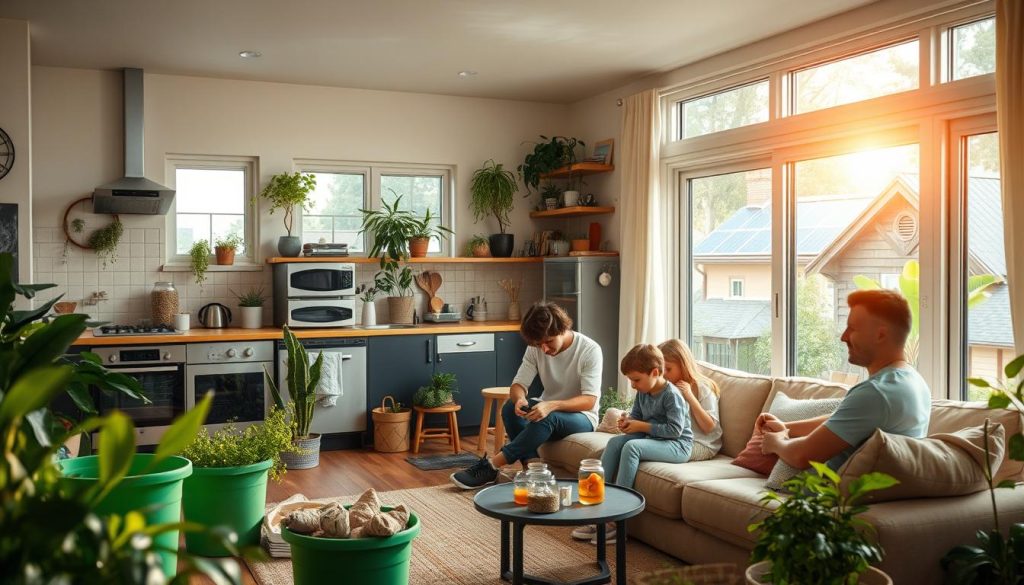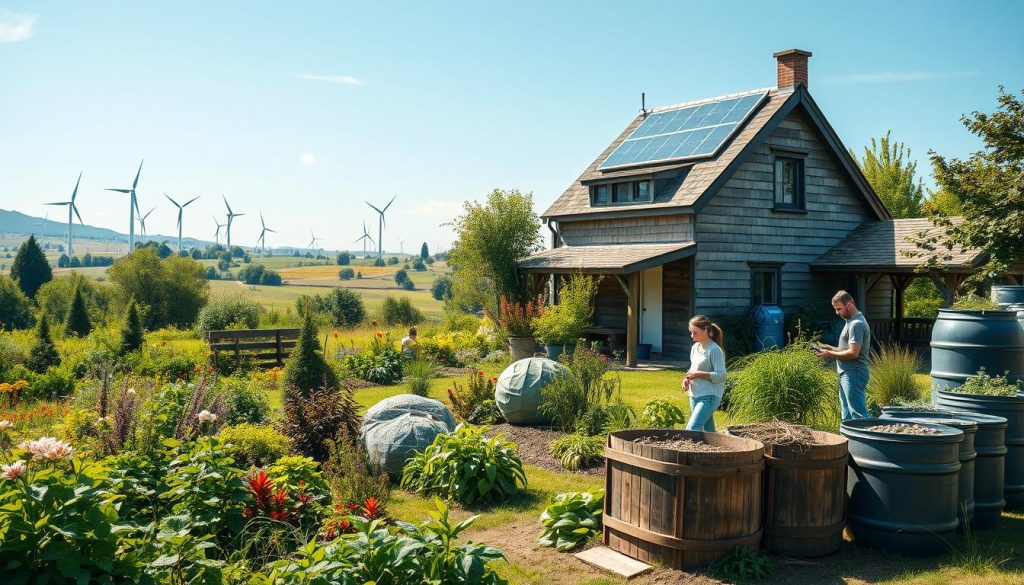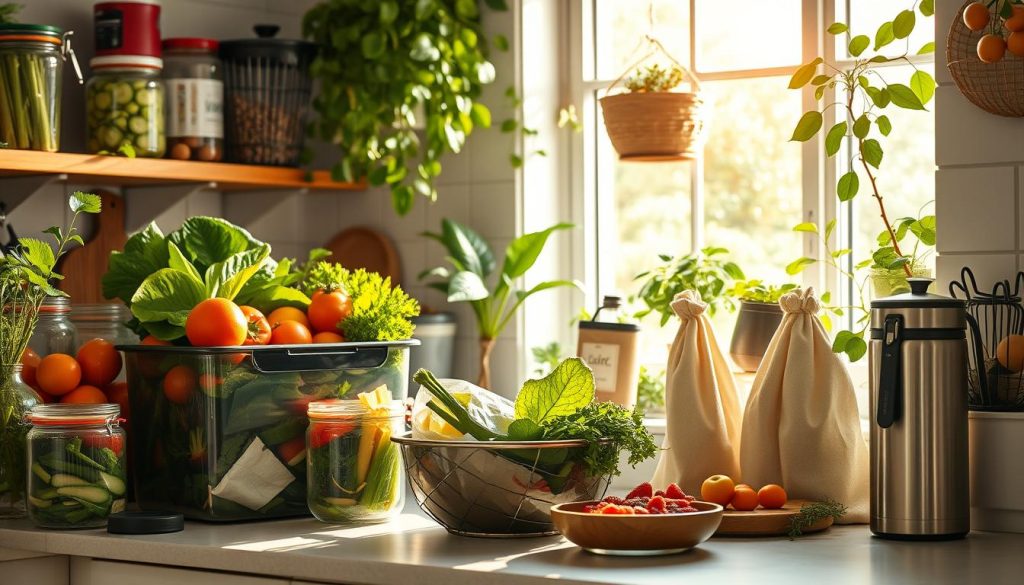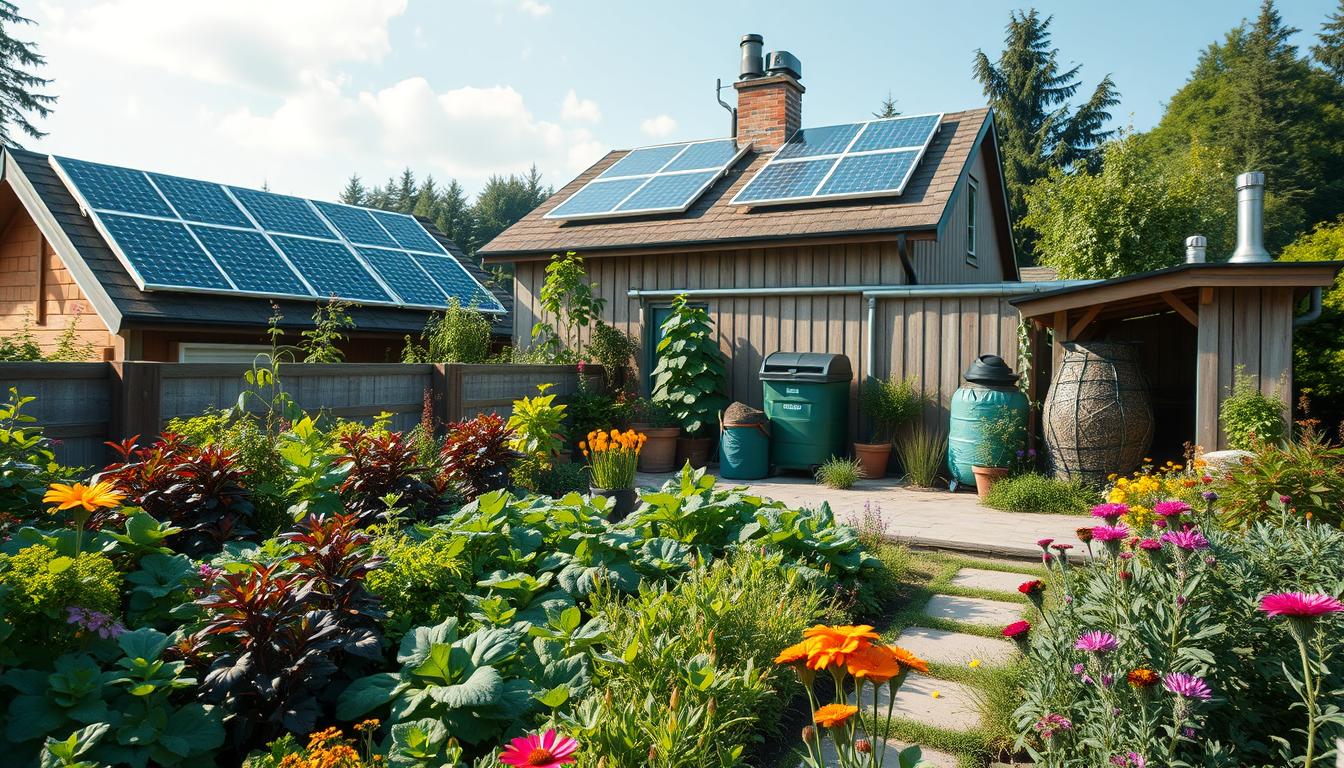I’ve always been drawn to green living. It’s more than a trend; it’s crucial for our planet’s future. I’m excited to share practical tips for living sustainably that can really help.
At the core of this journey is environmental conservation. Simple habits can lessen our impact on Earth and help our future. We can save energy and reduce waste, making our lives greener.
In this guide, we’ll cover many aspects of sustainable living. We’ll talk about making homes eco-friendly, choosing green transport, and smart shopping. These small steps can make a big difference for our planet.
Embracing Eco-Friendly Habits in Daily Life
Living an eco-friendly lifestyle is easier than you think. Small changes in your daily routine can make a big difference. Let’s look at simple ways to make your home more sustainable and practice mindful consumption.
Small Changes with Big Impact
I began my journey to ethical consumerism with small steps. I started using reusable bags for shopping and a refillable water bottle. These habits quickly became part of my routine and cut down my plastic use.
Creating a Sustainable Home Routine
At home, I focus on saving energy. I’ve switched to LED bulbs and unplug electronics when not in use. I also do laundry in cold water. These actions lower my carbon footprint and save money on bills.
Mindful Consumption Practices
Mindful consumption has changed my lifestyle. I now think twice before buying something. I choose quality items that last and support sustainable brands. This reduces waste and makes me more aware of my impact.
By adding these habits to my daily life, I’ve found living sustainably rewarding and achievable. It’s about making choices that reflect our values and protect our planet.
Reducing Your Carbon Footprint at Home

Making my home eco-friendly has been a game-changer. It saves money and helps the planet. Let’s look at ways to make your home greener.
Energy-efficient appliances are key. I got a new fridge that uses less power. It costs more at first, but saves money in the long run.
Insulation keeps your home comfy without using too much energy. I added it to my attic and sealed leaks. This move cut my energy use and bills.
Renewable energy has been the biggest change for me. I put solar panels on my roof. It’s cool to see my meter go backward on sunny days!
- Switch to LED bulbs for lighting
- Use a programmable thermostat to optimize heating and cooling
- Install low-flow showerheads and faucet aerators to conserve water
- Unplug electronics when not in use to avoid phantom energy drain
These changes have cut my home’s carbon footprint a lot. It’s rewarding to see how my choices help the planet. Every small step towards being green counts in the fight against climate change.
Sustainable Living: A Comprehensive Guide

Sustainable living is more than a trend; it’s a lifestyle that benefits our planet and future generations. As I explore green living practices, I find myself on a journey of discovery and positive change.
Understanding the Principles of Green Living
At its core, sustainable living aims to reduce our environmental impact. This means conserving resources, minimizing waste, and making eco-conscious choices. I’ve learned that small changes can lead to significant results when it comes to environmental conservation.
Benefits of Adopting a Sustainable Lifestyle
Embracing green living has brought numerous benefits to my life. Not only am I reducing my carbon footprint, but I’m also saving money and improving my health. Here’s a breakdown of the advantages:
| Benefit | Impact |
|---|---|
| Environmental | Reduced pollution and resource conservation |
| Economic | Lower utility bills and long-term savings |
| Health | Improved air quality and healthier food choices |
| Social | Stronger community connections and shared values |
Overcoming Challenges in Eco-Friendly Living
While the journey towards sustainable living is rewarding, it’s not without challenges. I’ve faced hurdles like higher upfront costs for eco-friendly products and the need to change long-standing habits. To overcome these, I focus on gradual changes and educate myself about the long-term benefits of green living choices.
Zero Waste Strategies for Everyday Life

I’ve found that living zero waste changes everything. Making small changes daily has greatly reduced my impact on the environment. Let’s look at some easy ways to live waste-free and consume mindfully.
Composting is key for me. I turn kitchen and yard waste into soil for my garden. This way, I avoid landfills and feed my plants naturally.
Recycling is important, but I focus on reducing first. I use reusable bags, bottles, and containers. I also buy items with less packaging or in bulk to reduce waste.
Upcycling has made me creative. I turn old things into new, useful items. Glass jars become storage, and old clothes make cleaning rags or quilts. This way, I use what I have longer and buy less.
Getting rid of single-use plastics is a big goal for me. I carry reusable utensils, straws, and napkins. At home, I use beeswax wraps instead of plastic wrap and choose glass or paper over plastic.
| Item | Reusable Alternative | Environmental Impact |
|---|---|---|
| Plastic water bottle | Stainless steel bottle | Reduces plastic waste |
| Disposable coffee cup | Insulated travel mug | Saves trees and reduces landfill waste |
| Plastic grocery bags | Reusable cloth bags | Decreases plastic pollution |
| Paper towels | Cloth napkins | Conserves resources and reduces waste |
By using these zero waste strategies, living sustainably feels natural. It’s a journey of mindful consumption that’s good for the planet and simplifies my life, saving money too.
Eco-Friendly Transportation Options
Choosing sustainable transportation is crucial for reducing our carbon footprint. It’s a big step towards living an eco-friendly lifestyle. Let’s look at some options that can make a big difference in our daily lives.
Biking and Walking for Short Distances
For trips under a mile, I walk or bike. It’s good for the environment and my health. Plus, it saves money. A good bike and comfy shoes make these choices even better.
Public Transit and Carpooling Benefits
For longer trips, I use public transit. Buses and trains are better for the environment than cars. When public transit isn’t available, I carpool with colleagues. This reduces traffic and pollution.
Electric Vehicles and Their Environmental Impact
For longer trips, I drive an electric vehicle. The initial cost was high, but I save on fuel and maintenance. As our power grid gets greener, electric cars become even more eco-friendly.
By choosing eco-friendly transportation, I’ve cut my carbon emissions. It’s a rewarding part of my journey to sustainable living. Small changes in how we move can have big positive impacts on our planet.
Green Energy Solutions for Your Home
I’m excited to share some fantastic renewable energy options for your home. These solutions not only promote sustainable living but also help reduce your carbon footprint. Let’s explore how you can power your house with clean, green energy.
Solar panels are a popular choice for homeowners. They harness the sun’s power to generate electricity, cutting down on utility bills. I’ve seen many neighbors install these sleek panels on their roofs, making a real difference in their energy consumption.
Wind turbines are another great option, especially if you live in a windy area. These modern windmills can generate significant power for your home. They’re not just for large wind farms anymore!
Geothermal systems use the earth’s constant temperature to heat and cool your home. While the initial installation cost might be higher, the long-term savings and efficiency are impressive.
Energy storage solutions, like home batteries, are game-changers. They store excess energy from your renewable sources, ensuring you have power even when the sun isn’t shining or the wind isn’t blowing.
| Energy Solution | Initial Cost | Energy Savings | Lifespan |
|---|---|---|---|
| Solar Panels | $15,000 – $25,000 | 50-75% on electric bills | 25-30 years |
| Wind Turbines | $8,000 – $32,000 | 30-60% on electric bills | 20-25 years |
| Geothermal Systems | $20,000 – $45,000 | 30-70% on heating/cooling | 25-50 years |
| Home Batteries | $5,000 – $15,000 | Varies with usage | 10-15 years |
Transitioning to these green energy solutions can significantly impact your home’s energy efficiency. It’s a big step towards a more sustainable lifestyle and a cleaner future for all of us.
Sustainable Food Choices and Practices
I’ve learned that choosing sustainable food is key to living mindfully. It helps the planet and keeps us healthy. Simple changes in what we eat can make a big difference.
Embracing Plant-Based Diets
Switching to a plant-based diet has opened my eyes. Eating more fruits, veggies, and whole grains is good for the planet and me. Beans and lentils are great, tasty, and affordable protein sources.
Supporting Local and Organic Agriculture
Buying organic from local farmers is a big part of my sustainable living. I love going to farmers’ markets for fresh, local produce. It helps local economies, cuts down on emissions, and keeps my food free from harmful chemicals.
Reducing Food Waste in Your Kitchen
Reducing food waste has changed my kitchen. Meal planning helps me avoid buying too much. Composting and getting creative with leftovers have cut down my waste. It’s also saved me money and made my meals more interesting.
| Food Practice | Environmental Impact | Personal Benefit |
|---|---|---|
| Plant-based diet | Reduced carbon emissions | Improved health |
| Buying organic products | Less pesticide use | Cleaner food |
| Reducing food waste | Less landfill waste | Cost savings |
By adopting these sustainable food practices, I’ve made a real difference. I enjoy delicious, healthy meals while helping the planet.
Ethical Consumerism: Making Informed Choices
Ethical consumerism is key to living sustainably. It’s about choosing wisely when we shop. This way, we support companies that care for the planet and people.
To be mindful in our consumption, we should research brands first. Look for eco-labels and certifications. These signs show a company’s dedication to being green.
Choosing wisely isn’t always simple, but it’s important. I aim to buy items that match my values. This might mean picking products made from recycled materials or supporting fair businesses. Every purchase is a vote for the world we desire.
Embracing ethical consumerism helps me contribute to a sustainable future. It’s not about being flawless, but about making better choices when we can. Small actions can add up to big changes if we all join in.
